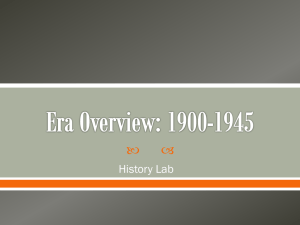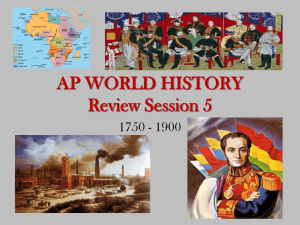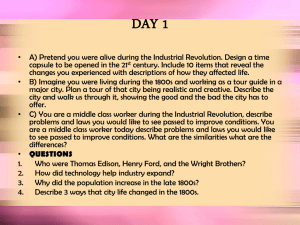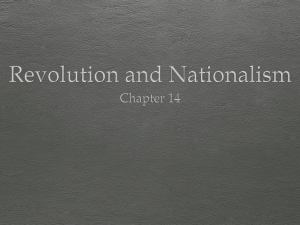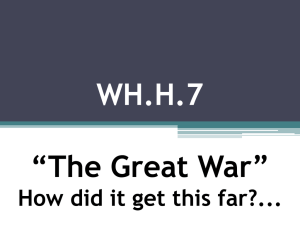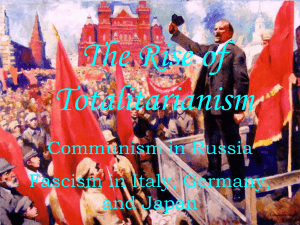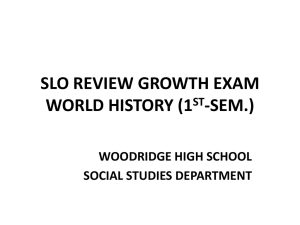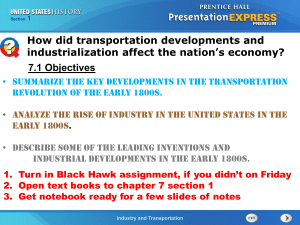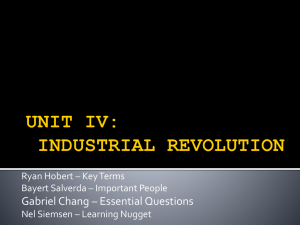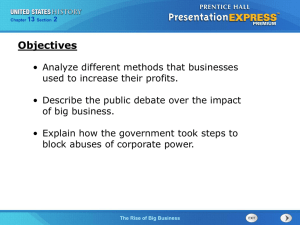industrial age world wars
advertisement
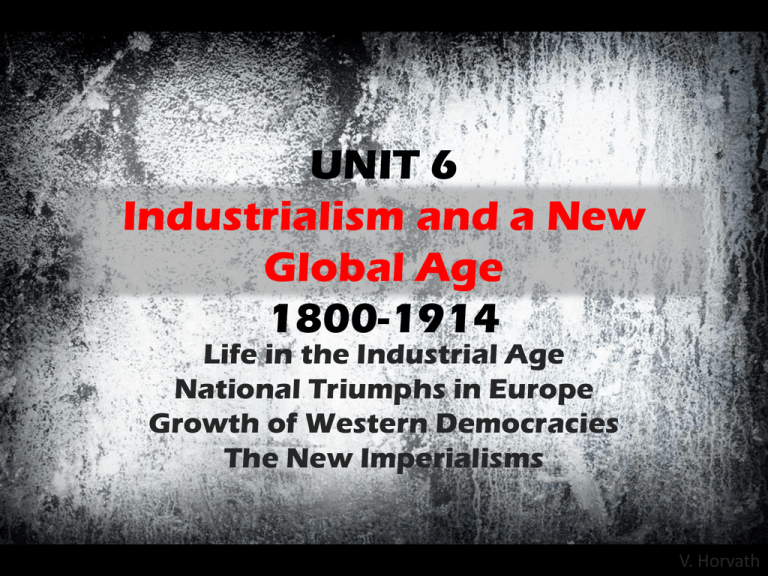
UNIT 6 Industrialism and a New Global Age 1800-1914 Life in the Industrial Age National Triumphs in Europe Growth of Western Democracies The New Imperialisms V. Horvath Chapter 22 Life in the Industrial Age 1800-1914 Chapter Overview 1. The Industrial Revolution Spreads 2. The World of Cities 3. Changing Attitudes and Values 4. A New Culture The Industrial Revolution Spreads • The Big Idea – The Second Industrial Revolution was marked by the spread of industry, the development of new technologies, and the rise of big business • Vocabulary – Dynamo, assemebly line, stock, cartel • Focus/Review – What industrial powers emerged in the 1800s? What impact did new technology have on industry, transportation, and communication? How did big business emerge in the late 1800s? • Pg 544 Spread of the Industrial Revolution 1. Identify the following: Alfred Nobel, Michael Faraday, Thomas Edison, Hendry Ford, Orville and Wilbur Wright, Alfred Krupp 2. How did the Industrial Revolution spread in the 1800s? 3. How did technology help industry expand? The World of Cities • The Big Idea – The population of cities grew as people moved to urban centers for jobs • Vocabulary – Germ theory, urban renewal, mutual-aid society • Focus/Review – What was the impact of medical advances in the late 1800s? How had cities changed by 1900? How did working-class struggles lead to improved conditions for workers? • Pg 551 Cities Expand 1. Identify the following: Louis Pasteur, Robert Koch, Florence Nightingale, Joseph Lister 2. Why did population increase in the late 1800s? 3. Describe three ways that city life changed in the 1800s Changing Attitudes and Values • The Big Idea – The Industrial Revolution changed the social order in the western world, and new ideas challenged long-held traditions • Vocabulary – Cult of domesticity, temperance movement, women’s suffrage, social gospel • Focus/Review – What values shaped the new social order? How did women and educators seek change? How did science challenge existing beliefs? What role did religion play in urban society? • Pg 555 Society Changes 1. Identify the following: Atomic theory, Charles Lyell, Social Darwinism 2. How did the social order change in industrial nations? 3. Describe three values associated with the middle class 4. What were the main goals of the women’s movement? Why did it have such strong opposition? A New Culture • The Big Idea – New artistic styles emerged as a reaction to the Industrial Revolution • Vocabulary – Romanticism, realism, impressionism • Focus/Review – What themes shaped romantic art, literature, and music? How did realists respond to the industrialized, urban world? How did the visual arts change? • Pg 562 Romanticism, Realism, Impressionism 1. Identify the following: Lord Byron, Johann Wolfgang von Goethe, Beethoven, Charlotte Brote, Charles Dickens, Claude Monet 2. Explain romanticism, realism, and impressionism Chapter 23 Nationalism Triumphs in Europe 1800-1914 Chapter Overview 1. Building a German Nation 2. Strengthening Germany 3. Unifying Italy 4. Nationalism Threatens Old Empires 5. Russia: Reform and Reaction Building a German Nation • The Big Idea – Otto von Bismarck, the Chancellor of Prussia, led the drive for German unity • Vocabulary – Chancellor, annex, Kaiser, Reich • Focus/Review – What early changes promoted German unity? How did Bismarck unify Germany? What was the basic political organization of the new German empire? • Pg 570 Unifying Germany 1. Identify the following: Otto von Bismarck, William I 2. What territorial and economic changes promoted German unity? 3. How did the emperor and his chancellor retain power in the new German government? Strengthening German • The Big Idea – Germany increased its power by building up its industry and armed forces • Vocabulary – Kulturkampf, social welfare • Focus/Review – What marked Germany as an industrial giant? Why was Bismarck called the Iron Chancellor? WHAT POLICIES DID Kaiser William II follow? • Pg 574 Making Germany Strong 1. How did Germany become an industrial giant in the late 1800s? 2. Why did Bismarck try to crush the Catholic Church and socialists? 3. What policies did William II introduce? Unifying Italy • The Big Idea – During the 1800s, influential leaders helped to create a unified Italy • Vocabulary – Anarchist, emigration • Focus/Review – What were the key obstacles to Italian unity? What roles did Count Camillo Cavour and Giuseppe Garibaldi play in the struggle for Italy? WHAT Challenges faced the new nation of Italy? • Pg 577 Italy Unites 1. Identify the following: Giuseppe Mazzini, Risorgimento, Victor Emmanuel II, Camillo Cavour, Giuseppe Garibaldi 2. What obstacles to unity did Italian nationalists face? What conditions favored unity? 3. Describe the problems Italians face after unification Nationalism Threatens Old Empires • The Big Idea – Desires for national independence threatened to break up the Austrian and Ottoman empires • Vocabulary – NONE • Focus/Review – How did nationalism contribute to the decline of the Austrian empire? What were the main characteristics of the Dual Monarchy? How did the growth of nationalism affect the Balkans? • Pg 581 Old Empires Feel the Heat 1. Explain how nationalism affected the Austrian empire 2. How was the Dual Monarchy organized? Why did it fail to end nationalist demands? 3. How did Balkan nationalism contribute to the decline of the Ottoman empire? Russia: Reform and Reaction • The Big Idea – Industrialization and reform came more slowly to Russia than to Western Europe • Vocabulary – Colossus, emancipation, pogrom, Duma • Focus/Review – How did conditions in Russia affect progress? Why did czars follow a cycle of absolutism, reform, and reaction? How did the problems of industrialization contribute to the growing crisis and outbreak of revolution? • Pg 584 Conditions in Russia 1. Identify the following: Bloody Sunday, October Manifesto 2. What conditions in Russia posed challenges to the nation in the early 1800s? How did czars usually react to change? 3. What were the causes of the revolution of 1905? How did Nicholas II respond? Chapter 24 Growth of Western Democracies 1815-1914 Chapter Overview 1. Britain Becomes More Democratic 2. A Century of Reform 3. Division and Democracy in France 4. Expansion of the United States Britain Becomes More Democratic • The Big Idea – Throughout the 1800s, political reform gradually expanded suffrage and made Parliament more democratic • Vocabulary – Rotten borough, secret ballot • Focus/Review – Why did reformers seek to change Parliament in the 1800s? What values did Queen Victoria represent? How did the Liberal and Conservative parties help bring a new era to British politics? • Pg 594 New Era in Britain 1. Identify the following: Benjamin Disraeli, Chartism, Victoria, William Gladstone 2. How did the Reform Act of 1832 change Parliament? 3. What middle-class values are associated with the Victorian age? A Century of Reform • The Big Idea – Parliament passed a wide variety of reform measures, but women’s suffrage and the status of Ireland remained difficult issues • Vocabulary – Free trade, capital offense, penal colony, home rule • Focus/Review – • Pg 597 Social and Economic Reforms 1. Identify the following: Corn Laws, Fabian Society, Emmeline Pankhurst, Catholic Emancipation Act, Great Hunger, Charles Stewart Parnell 2. Describe three social reforms that helped the British working class 3. Why did Irish nationalist oppose British rule? Division and Democracy in France • The Big Idea – Democratic reforms in France took place under the Second Empire of Napoleon III and its successor, the Third Republic • Vocabulary – Provisional, premier, libel • Focus/Review – What domestic and foreign policies did Napoleon III pursue? What impact did the Dreyfus affair and other challenges have on the Third Republic? How did the French government take steps toward reform in the early 1900s? • Pg 603 Third Republic France 1. Identify the following: Paris Commune, Georges Boulanger, Alfred Dreyfus, Jeanne-Elizabeth Schmahl 2. Describe the government of France under the Second Empire 3. Describe two reforms enacted in France in the early 1900s Expansion of the United States • The Big Idea – In the United States, the 1800s were a time of changing borders, growing industry, and expanding democracy • Vocabulary – Expansionism, abolitionist, secede, isolationism • Focus/Review – How did the United States extend its territory? How did American democracy grow before and after the Civil War? What impact did economic growth and social reform have on the United States? • Pg 608 Changes in the United States 1. Identify the following: Louisiana Purchase, Manifest Destiny, Frederick Douglass, Abraham Lincoln, Fifteenth Amendment 2. Describe how the United States grew in each of the following areas in the 1800s: a) territory b) population c)economy d) democracy Chapter 25 The New Imperialism 1800-1914 3. Chapter Overview 1. A Western-Dominated World 2. The Partition of Africa European Challenges to the Muslim World 4. The British Take Over India 5. China and the New Imperialism A Western-Dominated World • The Big Idea – In the late 1800s, industrial nations of the West engaged in imperialism and dominated much of the world • Vocabulary – Imperialism, sphere of influence • Focus/Review – What were the causes of the “new imperialism”? Why was western imperialism so successful? How did governments rule their empires? • Pg 618 Western Imperialism 1. Describe three causes of the new imperialism 2. How did people oppose western imperialism? 3. Describe three different forms of imperial rule The Partition of Africa • The Big Idea – By the end of the 1800s, the imperialist powers of Europe claimed control over most of Africa • Vocabulary – Jihad, elite • Focus/Review – What forces were shaping Africa in the early 1800s? How did European contact with Africa increase? How did Leopold II start a scramble for colonies? How did Africans resist imperialism? • Pg 621 The Scramble in Africa 1. Describe one development in each region of Africa in the early 1800s 2. How did European contact with Africa increase? 3. Describe two examples of African resistance to European imperialism European Challenges to the Muslim World • The Big Idea – During the 1800s, European nations extended their power into parts of the Muslim world • Vocabulary – Pasha, genocide, concession • Focus/Review – What were the sources of stress in the Muslim world? What problems did the Ottoman empire face? How did Egypt seek to modernize? Why were European powers interested in Iran? • Pg 627 Changes to the Muslim World 1. Identify the following: Mahdi, Young Turks, Armenians, Muhammad Ali, Suez Canal, Qajars 2. Describe problems that contributed to the Muslim decline. How did Europeans take advantage of these stresses? 3. Why did Russia and Britain compete for power in Iran? The British Take Over India • The Big Idea – Despite Indian opposition, Britain gradually extended its control over most of India • Vocabulary – Sepoy, viceroy, purdah • Focus/Review – what were the causes and effects of the Sepoy Rebellion? How did British rule affect India? How did Indians view western culture? What were the origins of Indian nationalism? • Pg 631 The British in India 1. What were the causes and effects of the Sepoy Rebellion? 2. Describe three effects of British colonial rule on India 3. How did Indian and British culture differ? China and the New Imperialism • The Big Idea – During the 1800s, Qing China declined as western powers used diplomacy and war to gain power in East Asia • Vocabulary – Trade surplus, trade deficit, extraterritorial • Focus/Review – What trade rights did westerners seek in China? What internal problems did Chinese reformers try to solve? How did the Qing dynasty come to an end? • Pg 635 Changes in China 1. Identify the following: Opium War, Treaty of Nanjing, Taiping Rebellion, Ci Xi, Open Door Policy, Boxers Uprising, Sun Yixian 2. How did westerners gain greater trading power in China? UNIT 7 World Wars and Revolution 1910-1955 World War I and Its Aftermath Revolution in Russia Nationalism and Revolution Around the World World War II and Its Aftermath V. Horvath Chapter 27 World War I and Its Aftermath 1914-1919 Chapter Overview 1. The Stage Is Set 2. The Guns of August 3. A New Kind of Conflict 4. Winning the War 5. Making the Peace The Stage Is Set • The Big Idea – In the late 1800s, a number of forces were pushing Europe to the brink of war • Vocabulary – Pacifism, militarism • Focus/Review – What efforts in the early 1900s were made toward peace? How did nationalism and international rivalries push Europe toward war? What were the causes and effects of the European alliance system? • Pg 678 Rivalries and Alliances 1. Identify the following: Allies and Central Powers 2. Describe how each of the following served to inflame tensions in Europe: a) nationalism b) Imperial rivalries c) militarism 3. Why did European nations form alliances? How did alliances increase fear? The Guns of August • The Big Idea – The assassination of Archduke Ferdinand ignited the Balkan “powder keg” and sparked World War I • Vocabulary – Ultimatum, mobilize • Focus/Review – How did ethnic tensions in the Balkans spark a political assassination? How did conflict between Austria-Hungary and Serbia widen? How do historians view the outbreak of World War I? • Pg 682 Assassination and Tension 1. Why was Archduke Ferdinand assassinated? What was the reaction to the assassination? 2. Describe how each of the following nations were drug into the conflict: Germany, Russia, France, and Britain 3. Who do modern historians think was responsible for the war? A New Kind of Conflict • The Big Idea – Modern weapons resulted in huge numbers of casualties and helped prevent either side from gaining an advantage • Vocabulary – Stalemate, no mans land, zeppelin, U-boat • Focus/Review – Why did a stalemate develop on the Western Front? How did technology make World War I different from earlier wars? How did the war become a global conflict? • Pg 685 A New Kind of War 1. Why did war on the Western Front turn into a stalemate? 2. Describe three ways new technology affected the war Winning the War • The Big Idea – In their efforts to achieve victory, governments committed all their nations resources to the war effort • Vocabulary – Total war, propaganda, atrocity, armistice • Focus/Review – How did World War I become a total war? What effect did the continuing war have on morale? What were the causes and results of American entry into the war? • Pg 690 Total War 1. Identify the following: Woodrow Wilson, Lusitania, Fourteen Points 2. What impact did wartime failures have on Russia? 3. Why did America enter the war? What impact did American entry have on the war? Making the Peace • The Big Idea – As Europe struggled to recover from the devastation of war, world leaders met in Paris to craft a peace treaty • Vocabulary – Pandemic, reparations, mandate • Focus/Review – What were the costs of the war? What issues faced the delegates to the Paris Peace Conference? Why were many people dissatisfied with the Treaty of Versailles and other peace settlements? • Pg 694 Dissatisfaction After the War 1. Identify the following: David Lloyd George, Georges Clemenceau, League of Nations, Treaty of Versailles 2. Describe conditions in Europe after WWI 3. How was Woodrow Wilson’s goals at the peace talks differ from those of other Allied leaders? Chapter 28 Revolution in Russia 1917-1939 Chapter Overview 1. Two Revolutions in Russia 2. From Lenin to Stalin 3. Life in a Totalitarian State Two Revolutions in Russia • The Big Idea – After two revolutions and a civil war, Lenin and the Communist party were the new rulers of Russia • Vocabulary – Proletariat, commissar • Focus/Review – Why did revolution occur in Russia in March 1917? Why did Lenin and the Bolsheviks launch the November revolution? How did the Communists defeat their opponents in Russia’s civil war? • Pg 702 Lenin and the Bolsheviks 1. Identify the following: Nicholas and Alexandra, Gregory Rasputin, Bolsheviks, Leon Trotsky, Red Army 2. What were the causes of the March Revolution? 3. How did Lenin adapt Marxism to conditions in Russia? From Lenin to Stalin • The Big Idea – After Lenin helped the country recover from civil war, Stalin established a brutal Communist dictatorship in the Soviet Union • Vocabulary – Command economy, kulak • Focus/Review – How did the Communist state develop under Lenin? What were the effects of Stalin’s five-year plans? Why did Stalin launch the Great Purge? How did Soviet foreign policy affect relations with the western powers? • Pg 707 Stalin and Lenin 1. How did Lenin make a compromise between the ideas of capitalism and communism? 2. What were the goals and results of Stalin’s five-year plans? 3. What were the causes and effects of the Great Purge? 4. How did Soviet foreign policy lead to difficult relations with the West? Life in a Totalitarian State • The Big Idea – Stalin turned the Soviet Union into a totalitarian state that regulated every aspect of the lives of its citizens • Vocabulary – Totalitarian state, atheism, socialist realism • Focus/Review – How did Stalin create a totalitarian state? How did communism change Soviet society? How did state control affect the arts in the Soviet Union? • Pg 713 Living in a Totalitarian State 1. What methods did Stalin use to create a totalitarian state? 2. Who made up the new elite in Soviet society? What special privileges did they enjoy? 3. How did the Soviet government make sure that most writers and artists conformed to the style of socialist realism? Chapter 29 Nationalism and Revolution Around the World 1910-1939 2. Chapter Overview 1. Struggle for Change in Latin America Nationalist Movements in Africa and the Middle East 3. India Seeks Self-Rule 4. Upheavals in China 5. Empire of the Rising Sun Struggle for Change in Latin America • The Big Idea – The desire for lands, better wages, and democratic reforms led to the Mexican Revolution • Vocabulary – Nationalization, economic nationalism, cultural nationalism • Focus/Review – What were the causes of the Mexican Revolution? What reforms were introduced in Mexico? How did nationalism affect Mexico? What was the Good Neighbor Policy? • Pg 722 Mexican Revolution 1. Describe three causes of the Mexican Revolution 2. Describe how nationalism affected Mexico 3. How did Franklin Roosevelt change United States policy toward Latin America? Nationalist Movements in Africa and the Middle East • The Big Idea – Following World War I, nationalist sentiment contributed to many changes in Africa and the Middle East • Vocabulary – Apartheid, polygamy • Focus/Review – How did Africans resist colonial rule? What signs of nationalism developed in Africa? How did turkey and Iran modernize? How did European mandates contribute to the growth of Arab nationalism? • Pg 726 Africa and the Middle East after WWI 1. How did Africans resist the impact of colonialism? 2. Describe examples of the rise of nationalism in Africa 3. Why were many Arabs angered by decisions made at the Paris Peace Conference after WWI? India Seeks Self-Rule • The Big Idea – Mohandas Gandhi and the Congress party led the drive for independence in India • Vocabulary – Ahimsa, Civil disobedience • Focus/Review – What sparked the Indian independence movement after WWI? How did Mohandas Gandhi influence the independence movement? What did the Salt March symbolize? • Pg 731 India and Independence 1. Who was Mohandas Gandhi? 2. How did the Amritsar massacre affect the movement for Indian independence? 3. Why did Gandhi organize the Salt March? Upheavals in China • The Big Idea – Civil war and foreign invasions plagued the new Chinese republic • Vocabulary – NONE • Focus/Review – What were the key challenges to the Chinese republic? What leaders emerged in the “new” China? How did invasion by Japan affect China? • Pg 734 The New China 1. Identify the following: Sun Yixian, May Fourth Movement, Guomindang, Jiang Jieshi, Mao Zedong, Long March 2. Why did the new republic of China fall into chaos after 1912? 3. Why did Jiang side with the Communists after 1931? Empire of the Rising Sun • The Big Idea – By the 1930, the Japanese military dominated a government that emphasized service to the nation and a policy of imperialistic expansion • Vocabulary – Diet, ultranationalist • Focus/Review – How did liberal changes affect Japan during the 1920s? How did nationalists react to Japan’s problems during the Great Depression? How did the militarists use their power? • Pg 738 Militarists in China 1. What liberal changes occurred in Japan in the 1920s? 2. How did nationalists deal with the Great Depression? 3. What goals did Japanese militarists pursue at home? What goals did they pursue overseas? Chapter 31 World War II and Its Aftermath 1931-1955 Chapter Overview 1. Aggression, Appeasement, and War 2. The Global Conflict: Axis Advances 3. The Global Conflict: Allied Successes 4. Toward Victory 5. From World War to Cold War Aggression, Appeasement, and War • The Big Idea – During the 1930, dictators undetermined world peace • Vocabulary – Sanction, appeasement, pacifism • Focus/Review – How did dictators and the Spanish Civil war challenge world peace? How did continuing German aggression lead Europe toward war? What factors encouraged the coming of war? • Pg 770 Aggressions Spur War 1. How did Japan, Italy, and Germany test the resolve of Western democracies before 1937? 2. Explain how other countries got involved in the Spanish Civil War 3. What acts of aggression did Germany commit in 1938-39? How did other nations acts of appeasement lead to war? The Global Conflict: Axis Advances • The Big Idea – The early years of World war II were marked by Axis victories • Vocabulary – Blitzkrieg, radar, sonar • Focus/Review – What early gains allowed the axis powers to control much of Europe? What were the Battle of Britain and operation Barbarossa? How did Japan respond to growing American involvement? • Pg 775 Axis War 1. Identify the following: Dunkirk, Winston Churchill, Battle of Britain, Operation Barbarossa, Lead-Lease Act, Pearl Harbor 2. How did the Axis powers achieve victories in 1939-40? 3. Why did General Tojo order a surprise attack on the United States? The Global Conflict: Allied Successes • The Big Idea – In 1942 and 1943, the tide of war began to turn as Allied forces won key victories • Vocabulary – Genocide, reparations • Focus/Review – How did Germany and Japan treat people in occupied lands? How did the Allies turn the tide of war? How did the Red Army and the Allied invasion of France undo German Plans? • Pg 781 Allies Turn the Tide of War 1. Identify the following: Holocaust, Battle of Stalingrad, D-Day 2. How did Hitler try to achieve a “new order” in Germany? How did the Japanese treat people they conquered? 3. How did the Allies turn the tide of war? Toward Victory • The Big Idea – Continued Allied successes led to victory over Germany and Japan in 1945 • Vocabulary – Island-hopping, kamikaze • Focus/Review –How was the Pacific war fought? How did the Allies defeat Nazi Germany? What debates surrounded the defeat of Japan? • Pg 787 Nazi’s Defeated & War in the Pacific 1. Identify the following: Battle of the Coral Sea, Battle of the Bulge, V-E Day, Harry Truman 2. How did the United States fight the war in the Pacific? 3. How did the Allies defeat Germany? 4. How was Japan defeated? From World War to Cold War • The Big Idea – As the war ended, new tensions developed between the United States and the soviet Union • Vocabulary – Containment, satellite • Focus/Review – What issues arose in the aftermath of war? Why did the Allies organize the United Nations? How did the breakup of the wartime alliance lead to new conflicts? • Pg 791 Aftermath of War 1. What are the UN and NATO? 2. How did the Allies try to hold the Axis leaders responsible for the war? 3. List two causes of the Cold War
